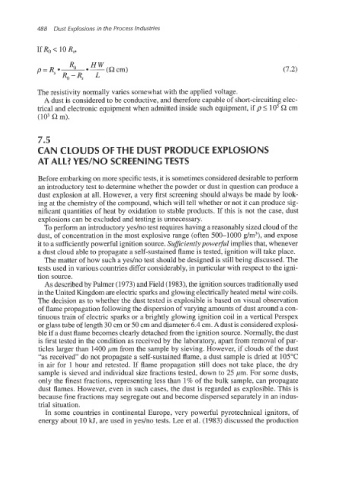Page 521 - Dust Explosions in the Process Industries
P. 521
488 Dust Explosions in the Process Industries
If Ro < 10 R,,
The resistivity normally varies somewhat with the applied voltage.
A dust is considered to be conductive, and therefore capable of short-circuiting elec-
trical and electronic equipment when admitted inside such equipment, if p I lo5Q cm
(lo3i2 m).
7.5
CAN CLOUDS OF THE DUST PRODUCE EXPLOSIONS
AT ALL?YES/NO SCREENING TESTS
Before embarking on more specifictests, it is sometimesconsidereddesirableto perform
an introductory test to determine whether the powder or dust in question can produce a
dust explosion at all. However, a very first screening should always be made by look-
ing at the chemistry of the compound,which will tell whether or not it can produce sig-
nificant quantities of heat by oxidation to stable products. If this is not the case, dust
explosions can be excluded and testing is unnecessary.
To perform an introductory yesho test requires having a reasonably sized cloud of the
dust, of concentration in the most explosive range (often 500-1000 g/m3),and expose
it to a sufficiently powerful ignition source. Sufficientlypowerful implies that, whenever
a dust cloud able to propagate a self-sustained flame is tested, ignition will take place.
The matter of how such a yesho test should be designed is still being discussed. The
tests used in various countries differ considerably, in particular with respect to the igni-
tion source.
As describedby Palmer (1973) and Field (1983), the ignition sources traditionallyused
in the United Kingdom are electric sparks and glowing electrically heated metal wire coils.
The decision as to whether the dust tested is explosible is based on visual observation
of flame propagation following the dispersionof varying amounts of dust around a con-
tinuous train of electric sparks or a brightly glowing ignition coil in a vertical Perspex
or glass tube of length 30 cm or 50 cm and diameter 6.4 cm.A dust is considered explosi-
ble if a dust flame becomes clearly detached from the ignition source. Normally, the dust
is first tested in the condition as received by the laboratory, apart from removal of par-
ticles larger than 1400 pm from the sample by sieving. However, if clouds of the dust
“as received” do not propagate a self-sustained flame, a dust sample is dried at 105°C
in air for 1 hour and retested. If flame propagation still does not take place, the dry
sample is sieved and individual size fractions tested, down to 25 pm. For some dusts,
only the finest fractions, representing less than 1% of the bulk sample, can propagate
dust flames. However, even in such cases, the dust is regarded as explosible. This is
because fine fractions may segregate out and become dispersed separately in an indus-
trial situation.
In some countries in continental Europe, very powerful pyrotechnical ignitors, of
energy about 10 kJ, are used in yesho tests. Lee et al. (1983) discussed the production

